By Eric Vandenbroeck 18 Jan. 2018
In my article about the recent standoff
between India and China I mentioned that Beijing could be replicating its approach in the South China Sea. A few days ago a Chinese nuclear attack submarine
surfaced near Japan northwest of the disputed Senkaku Islands and hoisted the Chinese flag
which comes just days after four China Coast Guard vessels entered Japanese
territorial waters.
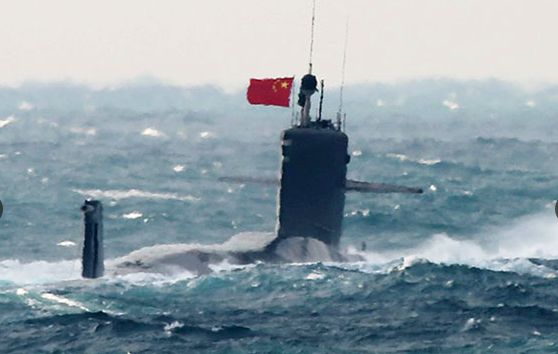
This while shortly before, on 3 January, news reports emerged in India that China had
crossed 200 meters into Indian territory near the Doklam
plateau, and the Head of the Indian Army General Bipin Rawat said bilateral bonhomie had returned to the same level that
existed before the 73-day troop faceoff in the region last year. According to AllSource Analysis, also imagery of the Chinese air bases
near Lhasa and Shigatse shows a significant presence
of fighter aircraft and a notable increase in helicopters, as well as
deployments of KJ-500 airborne early warning and command aircraft, components
of the HQ-9 long-range surface-to-air missile system and Soar Dragon unmanned
aerial vehicles at Shigatse Peace Airport. The
Chinese made a number of major airfield upgrades at Shigatse
a new runaway was constructed by mid-December, nine aircraft aprons measuring
41 meters by 70 meters were built along the main taxiway and eight helipads
were set up in the northeast corner of the airfield. This construction, along
with the deployment of new equipment in greater numbers, highlights how China
has undertaken a serious effort to improve its capabilities close to the
disputed Line of Actual Control.
And it is clear that China wants to keep the US Pacific fleet as far
away from China as possible with an immediate focus on the so-called ‘first
island chain’, comprising islands off Russia’s peninsula of Kamchatka down past
Japan to Taiwan, and then to the Philippines and Malay peninsula. Eventually,
we might imagine, China could seek to extend its naval influence further and
perhaps as far away as Indonesia or even Australia.
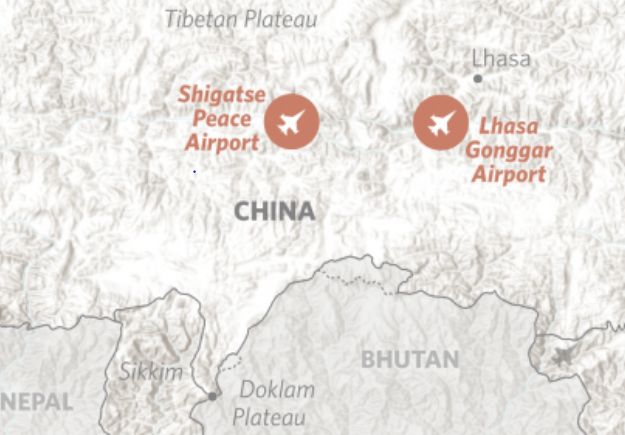
Not gone unnoticed by China observers all of this comes around the time
of a 15 Febr. report where the Chinese Communist Party emphasized its expanding global ambitions; in a remarkable 5,500
character treatise on the front page of Monday's "People's Daily.
We have known for some time that Global power is shifting to Asia to
which Europe and the USA have no choice but to adapt to that. What this article
will try to do is clarify the less known aspects of a unique present-day
nationalism among the Chinese people, as a result of which, many Chinese
believe today that a strong China reclaiming their core interests in Asia
should be compatible with a China engaging in the liberal international order
at the global level.
Last October, China’s Xi Jinping delivered the most consequential speech
since Mikhail Gorbachev stepped before cameras to formally dissolve the Soviet
Union. Addressing the Communist Party’s 19th Party Congress, Xi made clear that
China is ready to claim its share of global leadership. The implications of
this step are global.
China to displace rather than
replace the United States
Xi Jinping’s repeated promise “the great rejuvenation of the
Chinese nation,” likely will lead the PRC to be much more assertive in
foreign policy as it sees increasing opportunities to capitalize on the vacuum
and discord created by Trump’s “America First” policies. Xi furthermore has
displayed remarkable boldness and agility in bending the vast, sprawling party
system to his will.
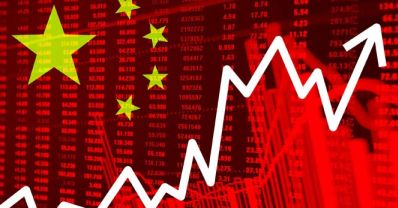
Since China has been shown to have many nationalisms, and its own
experience with nationalism and national identity differs from the study of
nationalism in general, failure to account for these other dimensions limits an
analysis of the degree of ethnocentrism in Chinese nationalism traditional
measures on nationalism may tell us very little about nation making in
contemporary China.
The development of China's new
nationalism
In an earlier study I pointed out that Nationalism
was the first principle of Sun Yat-sen’s Three Principles of the People, and
both the Kuomintang and the Chinese Communist Party (CCP) have adopted it. In the wake of the abortive
Hundred Days Reform of 1898, which ended when the empress dowager rescinded all
the reform decrees and executed several reformer officials, a number of radical
intellectuals started advocating the overthrow of the Manchu dynasty.
While the Han-narrative considers the Manchu to be
the historical culprit, as pointed out before, other
ethnic groups in the country today are also seen as threats to China’s
reawakening, particularly those that challenge Han or Sinocentric traditions and resist acculturation.
And although Mao Zedong in March 1953 still referred to “Han chauvinism”
to criticize his rival Kuomintang party, this drastically changed following the
1989 Tiananmen crackdown when history and memory were developed to become a new
nationalistic power.

To understand where the present-day re-invented Han nationalism in China
comes from we have to understand that during the 20th century, the Chinese
Communist Party utilized first communism and then patriotism to mobilize the
population.
After the end of the Cultural Revolution (1966-1976), when the most
serious challenge for the Chinese Communist Party (CCP) in the 1980s was a
crisis of faith in socialism, crisis of belief in Marxism, and crisis of trust
in the party. When the official Communist ideology lost credibility, the
Communist regime became incapable of enlisting mass support behind a socialist
vision of the future. There was a spiritual vacuum resulting from decades of
communist repression of both traditional and Western belief systems. Under
these circumstances, some intellectuals, particularly the younger generation of
intellectuals, turned to Western liberal ideas and called for Western style
democratic reform. The belief and faith crises finally evolved into a
pro-democracy movement and eventually led to the large-scale Tiananmen
demonstration in the spring of 1989. These crises became even more evident
following the international collapse of the communist ideology itself. China’s
communist rulers feared that, in the mind of ordinary Chinese, they had already
lost the “mandate of heaven” to rule china.
Where during the 1980’s, largely due to the relatively liberal political
environment and the policies of reform-minded top leadership, Chinese
nationalism had a moderate orientation, this
changed following the 1989 Tiananmen crackdown when history and memory were
developed to become a new power. Thus as seen, the ruling
elites identified nationalism as a critical source of legitimacy and
subsequently implemented a systematic and highly effective program of
reconstructing Chinese nationalism.
The centerpiece of the post-1989 state-sponsored revival of Chinese nationalism was the
so-called patriotic education campaign, a comprehensive program that
revamped history textbooks, reconstructed national narratives, and renovated
historical sites and symbols throughout China. The sole purpose of this program
was to rekindle the Chinese population’s sense of national humiliation and,
consequently, their antipathy toward the West. The “patriotic education
campaign” achieved remarkable success in reawakening the most parochial and
xenophobic strains in Chinese nationalism. Through official propaganda and a
distorted historical narrative, the CCP was able to convince large segments of
the Chinese population that the West would not want to see a powerful and
prosperous China. Periodically, the official propaganda apparatus would go into
overdrive whenever there were international incidents in which China was
apparently disrespected or poorly treated. A first example that we have
previously analyzed was the 1995-1996 Taiwan Strait Crisis. Other examples are
the accidental bombing of the Chinese embassy in Belgrade by NATO during the Kosovo
war in 1999, and the midair crash between a Chinese fighter jet and an American
navy reconnaissance plane over the South China Sea in 2001.Of course, American
responsibility in some of these made it easier for the Chinese regime to
convince their population that the United States harbored hostile intent toward
China. For instance, Washington attributed intelligence failure to the bombing
of the Chinese embassy in Belgrade. This might be true, but it sounded
unconvincing to the average Chinese, who firmly believed that the United
States, the world’s most advanced country, was incapable of making such dumb
mistakes.
Deng Xiaoping’s strategy meanwhile was the
redefinition of the “one-hundred year history of humiliation” as a new source
of legitimacy of the CCP’s rule and the unity of the Chinese people
and society.(1).
Besides the enormous investment of its resources in its nationalist project,
the CCP was significantly aided by other factors. Externally, the 1990s was a
decade during which the West made a moderate attempt to pressure China to
improve its human rights record through the threat of sanctions. Despites its
good intentions, this policy unfortunately backfired, because the CCP seized
upon the West’s threat of sanctions as evidence that the West, in particular
the United States, wanted to prevent China from becoming a powerful country.
Such propaganda resonated with the Chinese public. In the 1990s, the burgeoning
pro-independence movement in Taiwan, championed by President Lee Teng-hui, also
allowed the CCP to exploit Chinese nationalism because of the Chinese people’s
deep emotional attachment to Taiwan as “part of China.” The collapse of the
Soviet Union in 1991 was, in retrospect, a fortuitous event for the CCP, even
though the Chinese ruling elites were initially shocked by the fall of the
Soviet regime. The ensuing chaos in postcollapse
Russia and some of the former Soviet republics was played up by the Chinese
official media and cited as evidence of the dangers of democratic transition.
The message the Chinese authorities tried to convey was clear: only the CCP
could protect China’s national integrity and ensure its survival as a great
power.
Despite its enormous success in exploiting Chinese nationalism to boost
its rule, the CCP runs serious risks and faces uncertainties in the future if
it continues to count on the manipulation of nationalism to sustain public
support. The most obvious risk is that fueling nationalism at home could
severely damage China’s relations with the West, particularly the United
States. Economically, xenophobia could antagonize the West, which is China’s
most important trading partner. The Western business community may be alienated
as well. In the worst-case scenario, nationalism could escalate into
protectionism and a trade war between China and its Western trading partners.
In the realm of national security, jingoism is likely to lead to hardened
public attitudes and domestic political pressures, which could back the Chinese
government into a corner during crisis and make conflict more likely. The
ongoing dispute between China and Japan over
the Senkaku/ Diaoyu Islands in the East China Sea is a disturbing illustration. Deliberate manipulation of
public opinion, demonization of the Japanese leadership, and bombastic rhetoric
by the Chinese government not only led to violent nationwide anti-Japanese
riots in 2012 but also drove Beijing to adopt dangerous escalatory measures to
demonstrate its resolve, thus creating conditions under which an accidental
military clash has become a distinct possibility.(2)
Hugh White has presented a prescription to avoid a strategic clash,
arguing for power-sharing between the United States and China across the
Pacific.(3) The premise of the argument is concerned again, with Chinese
nationalism: China no longer accepts US primacy as the basis of an Asian order.
This is an understandable urge of a rising China, whose status should be
accepted and respected for the stability of the Asia-Pacific. One conundrum arising from this thesis, however, particularly for
China’s immediate neighbors, is whether a strong China rejecting US primacy can
be a benign hegemon in Asia. Many Chinese appear to believe so or at least like
to argue that it could, but their behavior particularly with regards to
territorial disputes toward some of their neighbors tends to convince their
neighbors otherwise. In this decidedly realist exposition of the strategic
relationship between the United States and China, what is often missing is the
examination of the place and role of Chinese neighbors in Asia in the
transformation of an Asia order. Obviously, Asian countries stand to be
directly impacted by the behaviours of a powerful
China.
For example, when Deng Xiaoping started to emphasize patriotism by using
modern history as a new source of unity of the Chinese people. Unwittingly,
therefore, “Japan came to be embroiled in China’s new quest to promote
patriotism amid the struggles for economic reform.” 19 Thus, Michael Yahuda
argues that the structural origin of the history problem between Japan and
China lies in “changes in the domestic politics of identity within China.” 20
Deng Xiaoping emphasizing patriotism by using modern history as a new source of
unity of the Chinese people, unwittingly, therefore, Japan came to be embroiled
in China’s new quest to promote patriotism amid the struggles for economic
reform. And thus the structural origin of the history problem between Japan and
China lies in changes in the domestic politics of identity within China.
Significantly, the Nanjing Memorial, officially named the “Memorial Hall of the Victims in
Nanjing Massacre by Japanese Invaders,” was opened on August 15,
1985. This was followed by the opening of the “Museum of the War of Chinese
People’s Resistance against Japanese Aggression” on July 7, 1987,
commemorating the fiftieth anniversary of the Marco Polo Bridge Incident. Since
the erection of these two major museums, the CCP “began to downplay the civil
war in favor of a national war against Japan.” (6) The message of these museums
is that of victimization by the Japanese aggressors, which is connected to the
overall emphasis on Chinese history of humiliation since the Opium War of 1840–
1842, which resulted in the loss of Hong Kong to the British. (7) On the
diplomatic front, China seized the occasion of the Japanese mass media report
in June 1982 that the Ministry of Education of Japan instructed a history
textbook draft expression of “aggression toward Northeast China” to be changed
to “advance toward Northeast China,” in describing the nature of Japanese
actions in the 1910s and the 1920s, prior to the establishment of Manchukuo in
1932. After some delay, the Chinese government started extensive campaigns to
criticize Japan in Chinese media. The textbook issue had thus become the very
first case of the history controversy between Japan and China in the postwar
years. In response, the Kiichi Miyazawa cabinet decided to add a “neighborly
country clause” to the textbook inspection criteria. In early September, the
Chinese government accepted these efforts by Japan, and the issue subsided.(8)
Then came the controversy over the Yasukuni Shrine in the summer of
1985. Until then, almost all prime ministers of postwar Japan had visited the
Yasukuni Shrine annually during their tenures. It had never been raised as a
diplomatic issue until August 1985, when China, having said nothing about the
previous nine visits by Yasuhiro Nakaosne to the
Yasukuni Shrine as prime minister, suddenly made a diplomatic issue of his
tenth visit, with the logic that this visit was made as an official one.
Nakasone compromised diplomatically, and Tokyo and Beijing struck a deal,
agreeing to the gentlemen’s agreement that prime minister, foreign minister,
and cabinet secretary would not visit the Yasukuni Shrine while in office, but
that China would condone the visits by other officials and politicians. (9) The
Japanese government thus attempted to deal with the new “history problem” in a
conciliatory manner. Perhaps the Chinese leadership was confident that they
should be able to control the dual aspects of Deng Xiaoping’s strategy, that
is, implanting history as a new source of unity of the Chinese people,
underpinning the legitimacy of the CCP rule, and gaining the upper hand against
Japan in a moral sense, while advancing cooperation with Japan as an important
supporter of Chinese economic modernization and development. In the 1990s,
however, Japan started to adjust its security policies to changing security
environments in the post-Cold War era in the direction of becoming a “normal”
country, as seen below. This phenomenon of “normalizing” Japan then became
entangled with the history problem, creating a typical vicious cycle between
Japan and China involving popular emotions and domestic politics of both
nations. The territorial disputes over the Senkaku (which China calls Diaoyu)
Islands became a symbolic issue aggravating the vicious cycle. When China was in the throes of revolution of
the Chinese model under Mao Zedong, the “Senkaku/ Diaoyu” issue was
nonexistent. The People’s Daily dated January 8 1953, in its support for the
people in Okinawa fighting against the American occupation, defined the Okinawa
Archipelago as consisting of seven groups of islands including the Senkaku.(10)
Against these backgrounds, for Tokyo, it came entirely out of the blue that
China contested the Japanese ownership in December 1971 (Taiwan did so a bit
earlier in the late 1960s). Chinese Foreign Ministry’s statement said that the
“Diaoyu” islands had been part of Taiwan since “ancient times,” thus claiming
the Chinese sovereignty for the first time in history. (11) In the meantime,
Deng Xiaoping said in 1978 that he would wish the future generation to handle
the issue wisely, but in 1992, China announced the territorial law designating
“Diaoyu” as Chinese territory. This was an attempt at virtually changing the
status quo, but Japan did not respond with any countermeasures, and China did
not take any further actions.
China's development of
asymmetric military capabilities
Indeed, perhaps nowhere has Beijing been more entrepreneurial than in
its military strategy. Its “anti-access/area-denial” (A2/AD) doctrine, for one
thing, was a masterstroke of innovation: By developing relatively low-cost asymmetric military capabilities, the country has been able to
greatly complicate any U.S. plan to come to the aid of Japan, the Philippines,
or Taiwan in the event of war. For another thing, instead of confronting the
United States to push its military out of the Asia-Pacific region, China has
engaged in subtler activities, such as harassing U.S. ships and aircraft with
nonmilitary means, which allow it to maintain a degree of deniability and
discourage a U.S. response. Thanks to such tactics, China has made significant
political and territorial gains without crossing the threshold into open
conflict with the United States or its allies. China's ultimate goal is to push
the United States out of the Indo-Pacific and rival it on the global stage.
China has also avoided sparking a concerted response from the United
States by deliberately delaying the modernization of its military. As Chinese
leader Deng Xiaoping famously put it, “Hide your strength, bide your time.”
Since countries tend to draw inferences about a challenger’s intentions from
the size and nature of its armed forces, China opted to first build up other
types of power--economic, political, and cultural--in order to project a less
threatening image.
When, in the 1970s, Deng started pursuing the “four modernizations”--of
agriculture, industry, science and technology, and national defense--he saved
military modernization for last. Throughout the 1980s, China-focused first on
building its economy; it then supplemented its burgeoning economic power with
political influence, joining international institutions throughout the 1990s
and the first decade of this century. At the turn of the millennium, China’s
military was still remarkably backward. Its ships didn’t have the capability to
sail safely far beyond the visual range of the coastline, its pilots were not
adept at flying at night or over water, and its nuclear missiles relied on
outmoded liquid fuel. Most of its ground units did not have modern, mechanized
equipment, such as up-to-date tanks.
It was not until the late 1990s that China began modernizing its
military in earnest. And even then, it focused on capabilities that were more
appropriate for dominating Taiwan than projecting power more broadly. China
also signaled that it sought to use its military for the global good, with Hu
publicly announcing that its forces would focus more on peacekeeping and
humanitarian relief than on war. Even China’s infamous A2/AD doctrine was
initially framed as a way of limiting the United States’ ability to intervene
in Asia rather than as a method for projecting Chinese power. China didn’t
launch its first aircraft carrier until 2012, and not until 2013 did it
undertake the structural reforms that will eventually allow its military to
contest U.S. primacy in the Indo-Pacific region in all domains.
In the maritime realm, China is exploiting a lack of international
consensus on the law of the sea. Although the United States insists that naval
vessels’ freedom of navigation is enshrined in international law, many other
countries contend that warships have no automatic right of innocent passage
through a country’s territorial waters--an argument made not just by China but
also by U.S. allies such as India. By taking advantage of these discrepancies
(and the United States’ failure to ratify the UN Convention on the Law of the
Sea), China is able to contest U.S. freedom-of-navigation operations within the
rubric of the existing international order.
Thanks to this novel strategy, China has been able to grow into one of
the most powerful countries in the world, second, perhaps, only to the United
States. And if it had chosen to persist with this strategy, the country would
have continued to stay off the United States’ radar screen. But rising powers
can delay provocation for only so long, and the bad news for the United
States--and for peace and security in Asia--is that China has now entered the
beginning stages of a direct challenge to the U.S.-led order. This said one
should be aware that China is trying to displace, rather than replace, the
United States.
However, Japan stands at the nexus of the dualism associated with the
rise of China in two fundamental ways. Firstly, Japan used to be, and arguably
still is, a major facilitator of China’s continuous engagement in the liberal
international order, and simultaneously on the forefront of the geopolitical
challenge by China over the “Senkaku/ Diaoyu” dispute. Secondly, the outcome of
this geopolitical challenge will have a decisive impact on the future of a
security order in the Asia-Pacific. Indeed, as an ultimate scenario, if China
succeeds in getting the Senkaku Islands without US involvement, this would
virtually mean the realization of the Chinese dream of establishing “a new
model of major power relations” across the Pacific.
For example, just during the last few days, Japan lodged a protest with
China after a Chinese military’s submarine surfaced in international waters
northwest of the disputed Senkaku Islands on the afternoon of Jan. 12 and hoisted the Chinese flag.
The incident comes just days after four China Coast Guard vessels entered Japanese territorial
waters around the disputed islets. While incursions into Japan’s contiguous
zone and territorial sea around the Senkakus are fairly common for Chinese
maritime law enforcement vessels and civilian fishing trawlers, incursions by
Chinese naval vessels are comparatively rare.
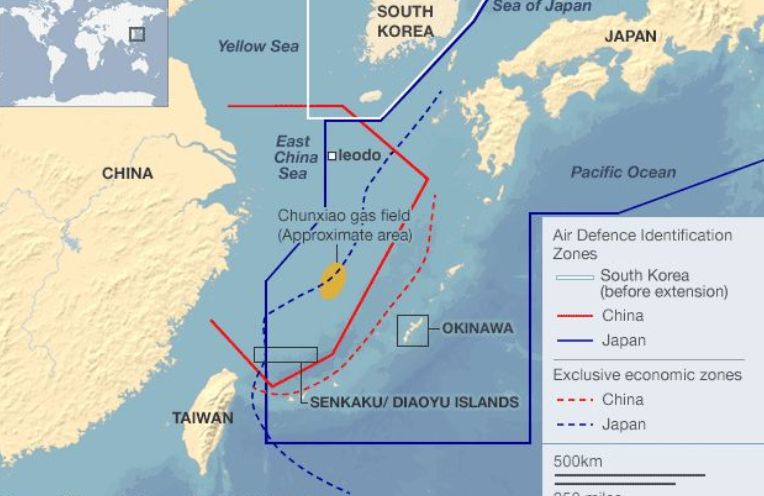
This was followed by the news that the Chinese naval submarine noticed
in waters near the Japanese-controlled Senkaku Islands and raised a Chinese
flag was a nuclear-powered attack
submarine. With a day later additional notice that Chinese submarine near
Senkakus ignored warnings. With the Japanese coast
guard saying that on Monday three additional Chinese patrol ships have entered
Japanese territorial waters off the Senkaku Islands in the 2nd such intrusion this year. Last week’s
incident and Monday’s incursion in the East China Sea raises tensions between
China and Japan shortly after an improvement in ties in late-2017.
In its newly released National Defense Strategy, the Pentagon openly
described Beijing as a “strategic competitor”, which is “using predatory
economics to intimidate its neighbors while militarizing features in the South
China Sea.” The document accuses Beijing of “seek[ing]
Indo-Pacific regional hegemony in the near-term and displacement of the United
States to achieve global preeminence in the future.”
In 2010, Chinese commentators began to describe the South China Sea as
one of China’s “core interests,” on a par with Taiwan, Xinjiang, and Tibet.
China was clearly on the offensive even in the East China and Yellow seas.
Occasionally rather difficult incidents occurred that fired up public opinion
in China, Japan, and the other countries involved. Defense forces were
strengthened. The issues involved not only ownership of the islands, but also
control over sea lanes and potentially large reserves of oil, natural gas, and
fish. China showed little willingness to compromise on these issues; neither
did most of the other states involved. The United States had no firm opinion on
the territorial issues involved, but insisted on open shipping lanes, here as
elsewhere. Confrontations can easily escalate. There is no guarantee that
diplomatic solutions will be found.(12)
There thus also is a debate regarding the theoretical implications of
the rise of China. The debate is essentially about the major themes and trends
in the transformation of the world order, that is, between realism anticipating
a geopolitical clash between a declining hegemon and an ascending power,(13)
and liberalism emphasizing the durability of the US-led liberal international
order and the likelihood of China to be accommodated in it.(14)
Evelyn Goh argues that the United States will remain a dominant power in
East Asia in the foreseeable future, and what is happening in the region is not
a power transition but “an order transition,” where the US hegemonic order is
being renegotiated.(15) If so, “middle power” cooperation among the China’s
neighbors may not be sustainable without the continuous role of the United
States as the backbone of stability in the Asia-Pacific region.
In addressing the question of the rise of China in the policy area the
discussions tend to fluctuate between the realist prognosis and the liberal
theorization. For instance, it has become a cliché to say that the Chinese
ascendance has dual and contradictory aspects, that is, sources of security
instability and economic prosperity. The role of the United States is also
characterized by dualism, that is, as being the most powerful superpower in the
world and yet also a declining power in relative terms. The strategic
relationship between China and the United States, therefore, has been complex,
fluctuating between hopes and despairs, cooperation and conflict.
In the eyes of the Chinese, however, there is perhaps no contradiction
in the seemingly dichotomous choice between engaging in the liberal
international order and geopolitical rivalry. In order to understand this
perception of the Chinese, it should be important to decipher the post-1989 Chinese nationalism as is
described earlier, in combination a growing sense of confidence and pride among
the Chinese, emanating from the recent spectacular rise to a great power
status. These sentiments combine to make up a unique present-day nationalism
among the Chinese people.(16)
As a result, many Chinese believe today that Asia
with China as the strong center is the natural state of Asia.
As seen by the recent incursions long-term implications arising from and
sustained by the Chinese nationalism aspiring for a new order in Asia will not
disappear easily and will continue to affect
various contemporary issues within the parameters of the international order.
It also appears that China has limited reciprocal legitimacy because its
behavior calls into question if China is sufficiently committed to coexistence
as a recipe for world order. In particular, China’s adherence to a historical
understanding of legitimacy that deviates from modern universal interpretations
of how sovereignty is acquired gives rise to suspicions as regards China’s
long-term intentions. Insufficient trust in China’s willingness to be a
responsible great power that looks after the common interests of states and not
just its own national interests means that as China exercises more and more
influence at the international level, other countries will interpret China’s
intentions as threatening their security. The resentment and pushback against
China’s growing influence that ensues create conflict and tension. If China is
to reach its “Teddy Roosevelt Moment” in the sense of taking on a visible and
active role on the world stage that involves major responsibility for global
security management, Beijing needs to leave behind ambitions to rectify
century-old violations of China’s alleged territorial and maritime space, even
if it weakens China’s geostrategic position in Asia in the interim. At issue is
not so much China’s growing strategic presence in its neighborhood; indeed,
that is to be expected from a rising power. Instead, it is China’s insistence
to correct historic wrongs that gives rise to concerns that restoration of the
Chinese motherland is accompanied by the resurrection of a Chinese hierarchical
hegemonic regional order that is ill-suited to the modern international system
of sovereign states.
Giving Xi Jinping’s recent confirmations and promises the PRC's more assertive
foreign policy is likely to continue as the country grows in confidence and
power, and as it sees increasing opportunities to capitalize on the vacuum and
discord created by Trump’s “America First” policies. The concept that Xi wants to promote is Chinese
diplomacy in the new era is to promote what China perceives as the construction
of a new type of international relations and a community of shared future.
Coming back to my remarks about the new Chinese Nationalism it should be
noted that during his 29 Nov. 2017 re-nomination speech Xi stressed
"patriotism" and that “it was time for his nation to
transform itself into a mighty force” that could lead the entire
world on political, economic, military and environmental issues. While in
reference to the above quoted treatise published 15 Febr. on the front page of
Monday's "People's Daily" Jonathan Sullivan, director of the China
Policy Institute at the University of Nottingham, remarked that: “It reflects
the Chinese leadership’s belief that right now is a huge opportunity for China
to stake out a global leadership role.”
For 2018 we thus can expect a growing influence for the PRC especially
in Asia and Central Asia, while Western countries and India, and possibly Japan, take a
harder line against CCP efforts to influence media and politics. Whereby also
the global business environment will have to adapt to new rules, standards, and
practices advanced by China, not just within that country’s borders but in
other countries where Chinese firms are increasing their presence and China’s
government is expanding its influence.
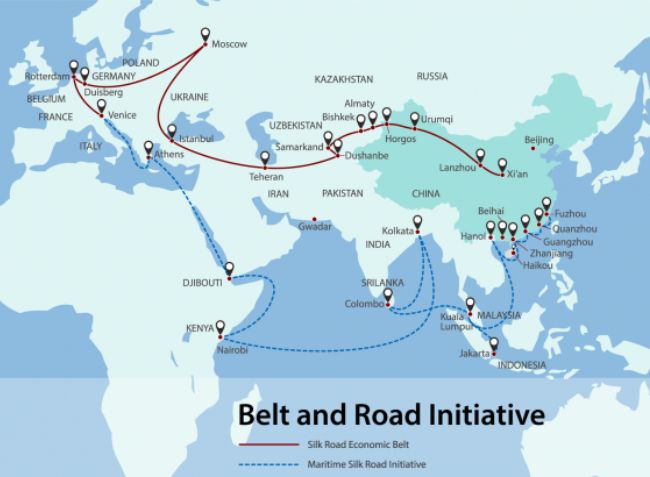
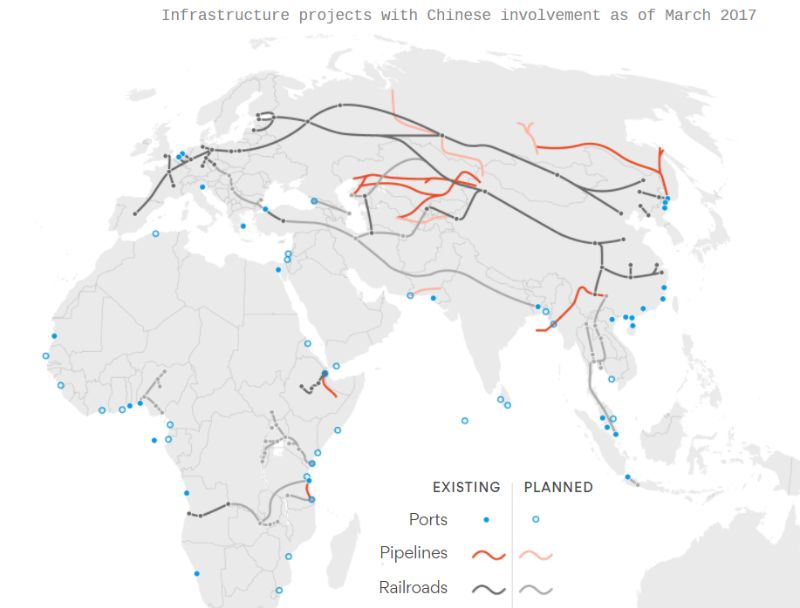
1. See more recently also Michael Yahuda, Sino-Japanese Relations after
the Cold War: Two Tigers Sharing a Mountain, London: Routledge, 2013.
2. Gregory J. Moore, “‘In Your Face’: Domestic Politics, Nationalism,
and ‘Face’ in the Sino-Japanese Islands Dispute,” Asian Perspective 38, no. 2
(April– June 2014): 219– 40.
3. Hugh White, The China Choice: Why We Should Share Power, Oxford:
Oxford University Press, 2013.
4. Michael Yahuda, Sino-Japanese Relations after the Cold War: Two
Tigers Sharing a Mountain, 2013
5. Ibid, p. 8
6. Daniel Sneider, “Interrupted Memories: The Debate over Wartime Memory
in Northeast Asia,” in Confronting Memories of World War II, ed. Daniel Chirot, Gi-Wook Shin, and Daniel Sneider (Seattle:
University of Washington Press, 2014), 50-54.
7. Ibid.,50-54.
8. Kokubun, Soeya, Takahara, and Kawashima, Nitchu Kankei-shi [Modern History
of Japan-China Relations], 150– 52.
9. After Nakasona, from Noboru Takeshita to
Shinzo Abe, there have been seventeen prime ministers of Japan, and only three
of them visited the Yasukini Shrine while in office,
i.e., Ryutaro Hashimono in 1996, Junichiro Koizumi
annually in 2001– 2006, and Shinzo Abe in 2013. There has never been a case of
a foreign minister’s visit, while Shinzo Abe’s visit in 2006 is the only
exception as cabinet secretary.
10. 人 民 日 報 < People’s Daily >, January 8, 1953. The article
is uploaded at: http://www.mofa.go.jp/mofaj/area/senkaku/images/qa/img03_l.jpg
11. The Japanese government did not protest this Chinese announcement
explicitly, by giving priority to the overall relationship with Beijing, with
which diplomatic normalization was achieved in September 1972. An internal
Foreign Ministry document, however, had already stated in July 1972,
anticipating diplomatic normalization with China, that “the Japanese government
is in no position to negotiate the sovereignty issue of the Senkaku islands
with any other government since it is the unequivocal fact that these islands
are Japanese territories.” Ministry of Foreign Affairs of Japan, “Nitchukan-no Kenan Jiko” [Pending issues between Japan and
China], July 10, 1972) disclosed by the freedom of information act of Japan;
Kokubun, Soeya, Takahara, and Kawashima, Nitchu Kankei-shi [Modern history
of Japan-China relations], 128.
12. Dyer, The Contest of the Century, 113-22; David W. Kearn Jr.,
“Air-Sea Battle and China’s Anti-Access and Area Denial Challenge,” Orbis,
Winter 2014, 132-46; Evan Braden Montgomery, “Contested Primacy in the Western
Pacific: China’s Rise and the Future of U.S. Power Projection,” International
Security, Spring 2014, 115– 49; Larry M. Wortzel, The
Dragon Extends Its Reach: Chinese Military Power Goes Global (Washington, DC:
Potomac Books, 2013).
13. John J. Mearsheimer, The Tragedy of Great Power Politics, New York:
W. W. Norton, 2001.
14. G. John Ikenberry, Liberal Leviathan: The Origins, Crisis, and
Transformation of the American World Order, Princeton, NJ: Princeton University
Press, 2011.
15. Evelyn Goh, The Struggle for Order: Hegemony, Hierarchy, and
Transition in Post-Cold War East Asia, Oxford: Oxford University Press, 2013.
16. Zhao Suisheng, A Nation-State by
Construction: Dynamics of Modern Chinese Nationalism (Palo Alto, CA: Stanford
University Press, 2004).
For updates
click homepage here